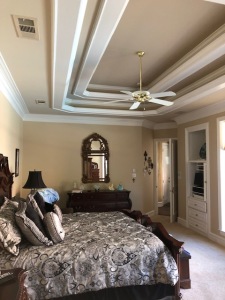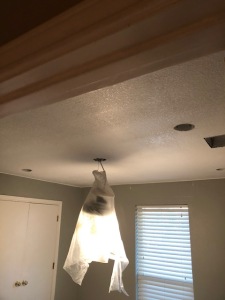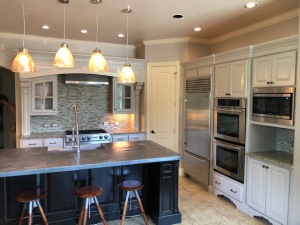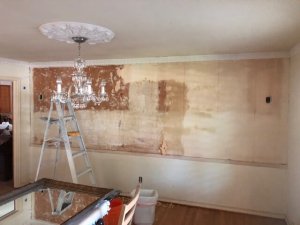When it comes to home maintenance, painting is one task that is best left to a professional. Painting contractors have the experience and the manpower to do the job properly and efficiently. They can also recommend the best type of paint for the project, taking climate and building material into consideration.
While you may be tempted to save money and turn this into a do-it-yourself project, your safety is important—professionals will have the special equipment needed to get up high and, more importantly, their own insurance, shielding you from liability. But there is a con: working with the wrong contractor. Be sure your contractor is insured, has a good reputation, and offers the best cost estimate to ensure you get the job done without any headaches.
There’s nothing like a fresh coat of paint to boost curb appeal and make an entire home feel fresh. But exactly how much does it cost to paint a house?
Average Cost to Paint a House
House-painting costs can vary significantly depending on your home’s square footage, where you live, and who is crunching the numbers.
But the pros at the trade organization Painting and Decorating Contractors of America (PDCA) can make a pretty good estimate. These are their ballpark figures for the average cost to paint a house, including labor and materials.
Cost to paint a house (both exterior and interior):
1-story 1,000 square feet: $2,500-$6,000
2-story 2,500 square feet: $6,750-$12,500
3-4-story 4,000 square feet: $10,000-$19,000
In addition to being affected by a home’s square footage, painting costs can vary based on the type of paint the chosen, the paint’s finish, the type of paint primer used, labor rates, and the type of exterior siding.
Free Estimates Call (972) 741-4995
How Much Paint Costs.
What type of paint materials you choose has a big impact on how much it’s going to cost to paint your home — not to mention how it looks and how long it lasts. To determine how much paint will cost, you first need to understand the different types, finishes, and quality of paint, and if you’ll need primer, too.
Paint Types
There are two types of paint: latex-based paint and oil-based paint.
Latex paint (also known as water-based paint) is the most common type of paint for home use, since it rolls on smoothly, dries quickly, is environmentally friendly, and tends to have less of an odor than oil-based paint. The main drawback of latex paint, though, is it’s less durable than oil-based paint.
Oil-based paint is commonly used for high-moisture areas, since these areas need more protection over time. Typically oil-based paints are superior to latex paints, take longer to dry, can create bad odor while drying, and contain more volatile organic compounds (VOCs), which essentially means they’re less environmentally friendly.
Here’s the cost breakdown for latex- and oil-based paints:
Latex-based paint: $20 to $70 per gallon
Oil-based paint: $30 to $70 per gallon
Paint Finishes
A paint’s finish can also affect its price tag. There are five main types of finishes: flat/matte, matte enamel, eggshell, satin, semi-gloss, and high-gloss. Each finish has its pros and cons, and their costs vary. Both latex-based paints and oil-based paints offer the full range of finishes.
Two aesthetic things to consider when selecting a finish are how shiny you’d like the surface to be and whether or not you want to hide any imperfections on the surface to be painted. Generally, higher-gloss paint finishes reflect light better than lower-gloss finishes, like eggshell and matte. That makes them shiny, and also causes them to highlight flaws.
- High-gloss paint is the most durable and easiest to clean of all paint sheens. It’s ultra-shiny, light-reflective, and hard (think appliance-paint tough). It is a good choice for areas that sticky fingers touch, though, such as cabinets, trim, and doors.
- Semi-gloss paint, which is slightly less durable than high-gloss paint, is well suited for rooms where moisture, drips, and grease are common and need to easily wipe away. This makes it appropriate for kitchen walls, bathrooms, and trim.
- Satin paint has a lovely luster that, despite the name, is often described as velvety. Because it’s easy to clean, it’s suitable for high-traffic areas—including kitchens, bathrooms, trim, and chair rails—though it reveals application flaws, such as roller or brush strokes.
- Eggshell paint falls between satin and flat on the sheen and durability scale. It’s essentially a flat, low-shine finish with little luster, like a chicken’s egg. Eggshell covers wall imperfections well and is a great finish for gathering spaces that don’t get a lot of bumps and scuffs.
- Flat, or matte finish on the no-shine end of the finish spectrum. A friend to walls that have something to hide, flat or matte paint (the terms are interchangeable) soaks up — rather than reflects — light, has the most pigment, and provides the most coverage. It’s good for adults’ bedrooms and other interior rooms that won’t be roughed up by kids. That’s because it’s tough to clean without taking paint off.
Generally, the higher the shine, the higher the cost:
- Flat/Matte: $20 to $50 per gallon, depending on brand
- Eggshell: $1-$5 more per gallon than flat of same brand
- Satin: $1-$5 more per gallon than eggshell of same brand
- Semi-gloss: $1-$5 more per gallon than satin of same brand
- High-gloss: $1-$5 more per gallon than semi-gloss of same brand
Paint Quality and Other Factors
Paint quality also affects paint price. Higher-grade paints tend to adhere to surfaces better and last longer. They also tend to be thicker. As a result, they cost more than lower-grade paints.
Major brands often offer a range of paint qualities—for example, Home Depot’s Behr sells Behr Premium Plus, Behr Premium Plus Ultra, and Behr Marquee (its higher-quality paint). An example of the cost difference between a gallon of semi-gloss Behr Premium Plus and Behr Marquee in the same color is $32 versus $46.
Another factor that can affect paint cost is color. For instance, trendy paints may cost substantially more than classic hues; a gallon of Sherwin-Williams’ popular Emerald Exterior Latex Paint is a whopping $83.99, compared to the brand’s more basic A-100 Exterior Acrylic Latex, which only costs $47.99 a gallon.
In addition, paint features such as mold and mildew resistance are important cost factors. Many mold-inhibiting bathroom paints, for instance, cost substantially more than ordinary latex-acrylic paint—sometimes close to twice the cost. Also, paints that come with warranties from the manufacturer may be more expensive depending on the length of the warranty. (A five-year warranty is standard.)
Paint Primer
Most paint jobs will require a layer of paint primer before paint is applied. Primer seals in stains, creates a more even finish, and ensures better adhesion of the paint to the surface. However, not all wall surfaces call for primer.
Applying primer over new or bare surfaces is a must, since it will seal the original material and prevent the paint from soaking into it. A layer of primer is also beneficial when painting walls with water damage, mildew stains, or greasy patches, since this will enable the paint to mask these surface stains.
If the walls are in decent shape, or the new paint color closely matches the old one, you can probably get away without using primer.
Some paints are two-in-one paint and primer products, or so-called “self-priming paints.” These paints are designed to seal and cover surfaces in one coat. But, here’s the secret: though it’s called a paint-and-primer-in-one product, there’s actually no primer in the mix—what you’re really working with is just a thicker paint that often doesn’t perform as well as using separate primer and paint.
The moral? Though two-in-paint can help you save time, it’s wise to opt for a separate primer in advance of most paint jobs.
There are three types of primers: oil-based, latex-based, and shellac-based. Their costs are as follows:
- Oil-based primers: $20 to $80 per gallon. An industry standard for decades, oil-based primers are ideal for unfinished or bare wood. They seal the porous surface of wood, enabling the coat of paint to better adhere to the surface.
- Latex-based primers: $20 to $80 per gallon. Ideal for preparing unfinished drywall and softwood (like pine) for painting, latex-based primers are less brittle than oil-based primers, which makes them less susceptible to peeling and cracking.
- Shellac primers: $40 to $63 per gallon. Excellent at blocking stains, shellac primer works well on walls that are susceptible to water or smoke damage.
Though all three primers can be used under latex paint, it’s best to use a latex-based primer for a latex paint, oil-based primer for an oil-based paint, and shellac primer for walls with stubborn stains.
Average Cost to Paint Interior of a House
According to PDCA, interior painting costs will depend largely on the square footage of your home. Here are their estimated averages:
- 1,000 square feet: $1,500-$3,000
- 2,500 square feet: $3,750-$7,500
- 4,000 square feet: $6,000-$12,000+
Average Cost to Paint the Exterior of a House
Exterior painting costs will vary depending on the size of your home:
- 1-story 1,000 square feet: $1,000-$3,000
- 2-story 2,500 square feet: $3,000-$5,000
- 3-4-story 4,000 square feet: $4,000-$7,000+
Those figures don’t account for siding materials—and some sidings cost more to paint than others because of their texture and the type of paint required to properly cover them.
Here are painting estimates for the five most common types of siding, in order of least to most expensive:
- Metal siding: $1,500 per 1,000 square feet
- Concrete siding: $2,000 per 1,000 square feet
- Vinyl siding: $2,000 per 1,000 square feet
- Wood siding: $2,000 per 1,000 square feet
- Stucco siding: $3,000 per 1,000 square feet
Labor Cost to Paint a House
While some professional painters will charge a flat fee for a painting project, most charge an hourly rate—about $25 to $100 per hour on average. Some painters will charge more for last-minute jobs (think 48 hours’ notice or less), travel costs (if you live far away, the painter may want extra money for travel time), or intensive prep work (e.g., removing mold or stains before painting). Depending on the painter, the rate may or may not include the cost of paint materials such as paint, primer, and supplies.
Repairs and improvements can also increase your painting budget. Painters may offer some of these additional services, but you may need to call in a specialist for others:
- Drywall repair: $115 to $380 per room
- Repairing plaster: $60 to $90 per hour or a fixed rate of $200 to $300 for minor to medium jobs.
- Mold remediation: $500 to $6,000 based on the size of the area and level of mold infestation.
- Patching holes: around $10 per square foot for resurfacing and repairing holes and cracks in the wall.
- Sanding: around $1.80 per square foot.
Additional factors that can affect a painter’s labor costs are the number of stories and the condition of the home. Generally, the more stories a house has, the higher the labor costs will be. And, if a home is older, prep work such as scrubbing siding or sanding aging wood could be more time consuming for the painter.
How Much Paint Supplies Cost.
Though you can save potentially save big bucks by not paying for someone else’s labor, there are trade-offs to doing the work yourself. For one thing, you’ll have to buy supplies such as drop cloths, tape, ladders, brushes, and rollers.
Drop Cloths
There are different types of drop cloths you can use to protect furniture and floors while painting. Here are the types and price estimates:
- Canvas drop cloths: $15 to $20 for 9×12-feet. Canvas cloths are the most expensive, but they are virtually indestructible—buy them once, and they’ll last for many years.
- Plastic drop cloths: $1 for 9×12-feet. Paint-proof, lightweight, and economical, plastic drop cloths are good for protecting furniture and cabinet covers. They can also be used to protect lawns and landscaping during painting.
- Paper drop cloths: $3 to $5 for 9×12-feet. Paper drop cloths provide a cheap way to cover furniture or windows while painting small, indoor jobs, such as touching up window trim. They’re absorbent and textured to hold paint. When you’re finished, you can just fold them up and throw them away. However, paper cloths are not the best option for protecting floors since they can tear easily.
- Paper/poly drop cloths: $2 to $6 for 9×12-feet. The best of both paper and plastic, these cloths are low-cost and disposable. They absorb paint drips while providing more protection for what’s underneath. They also provide some protection from slipping. Plus, you can cut paper/poly drop cloths to fit the space. But, like paper, paper/poly drop cloths can rip more easily than plastic or canvas drop cloths.
- Upcycled drop cloths: Have old shower curtains, drapes, or other sturdy material lying around? Both your wallet and the planet will thank you for hanging on to them for painting projects.
Painter’s Tape
Painter’s tape—a must for protecting areas that should not be painted, like crown molding—costs about $7 to $10 for a roll of 60 yards. Delicate surfaces, such as wallpaper or ceiling tiles, will require a lower adhesion tape than ordinary walls and trim.
Ladders and Scaffolding
Ladder prices vary based on size — though most homeowners can paint the interior of their home using a 16-foot extension ladder, which generally costs between $100 and $200. Folks in houses with low ceilings may even be able to get away with a step stool, the prices for which vary widely, from $30 to $100, depending on height and durability.
The right ladder to fit your exterior painting needs will vary by the size of your home, but generally, the job will require an extension ladder, which can run between $200 and $300.
Brushes and Rollers
Of course, paint brushes and rollers are also important line items on your budget sheet. A 3-inch-wide paint brush costs, on average, $10 to $20—though you’ll likely need an assortment of paint brush sizes for trim, corners, and narrow surface areas. Brushes come in a variety of bristle types and qualities, and each has a different purpose. Some are intended for specific paint types, finishes, and surfaces, so be sure to buy the right brushes for your painting job.
You’ll also need a set of paint rollers. Paint roller kits that include paint trays cost about $10 to $20. Like brushes, rollers are sold with different textures to suit different surface types, such as smooth or rough.
Having a professional paint your home from top to bottom, inside and outside has a number of advantages. For one thing, it’ll save you a ton of time by not having to do the work yourself. In addition, you won’t have to be concerned about safety issues, such as climbing a ladder to paint your house’s gutters. Best of all, you can expect a clean, attractive finished product from a professional painter.

Find a Competitive, Skilled Painter
Of course, the painter you choose to hire will be handling the lion’s share of the workload. Take these steps to find a reliable painter — someone you can trust to do a great job for a fair price:
Get quotes from at least three painters. Just like any other contractor, you’ll want to obtain several bids before deciding who gets your business. Have the painters come to view your property in person before they write you a formal bid. This way there will be no surprises when the painters show up to perform the work.
Compare offers. The painter offering the lowest rate may not always be the best painter for the job. Indeed, the total cost isn’t the only factor to consider when choosing between multiple bids. You’ll want to look at contracts side by side to ensure you’re making an apples-to-apples comparison. Are the same materials being used? Are the same services included? Does the painter provide a warranty?
Ask the right questions. Before signing a contract, make sure to ask a painter these questions: How long has your company been in business? Do you use subcontractors? Do you have proof of business liability insurance and workmen’s compensation insurance? How much wall prep is included in the estimate? How do you communicate with your clients?
Interview past clients. Talking to former customers is always a good idea. But, to ensure you’re getting honest feedback — not just feedback from people who have been handpicked by the painter to sing their praises — ask to speak to the painter’s three most recent clients. When you speak to them, ask about specifics. Find out whether the painters showed up on time, protected furniture from paint spills, kept the house clean, and completed the project on schedule.
Oftentimes you can get a discount for doing multiple jobs all at once. So if you’re thinking about painting your entire house, inside and out, there could be a benefit to doing it at the same time.
We hope this article was helpful.
Ron Bledsoe, Owner, Paint Ovations








